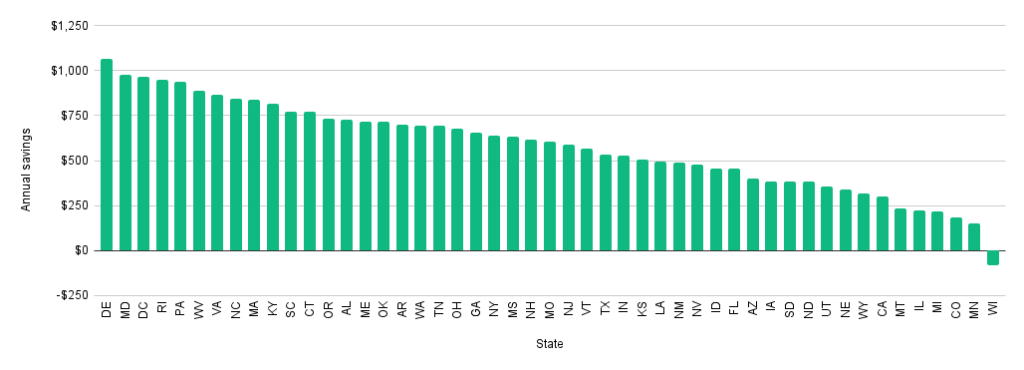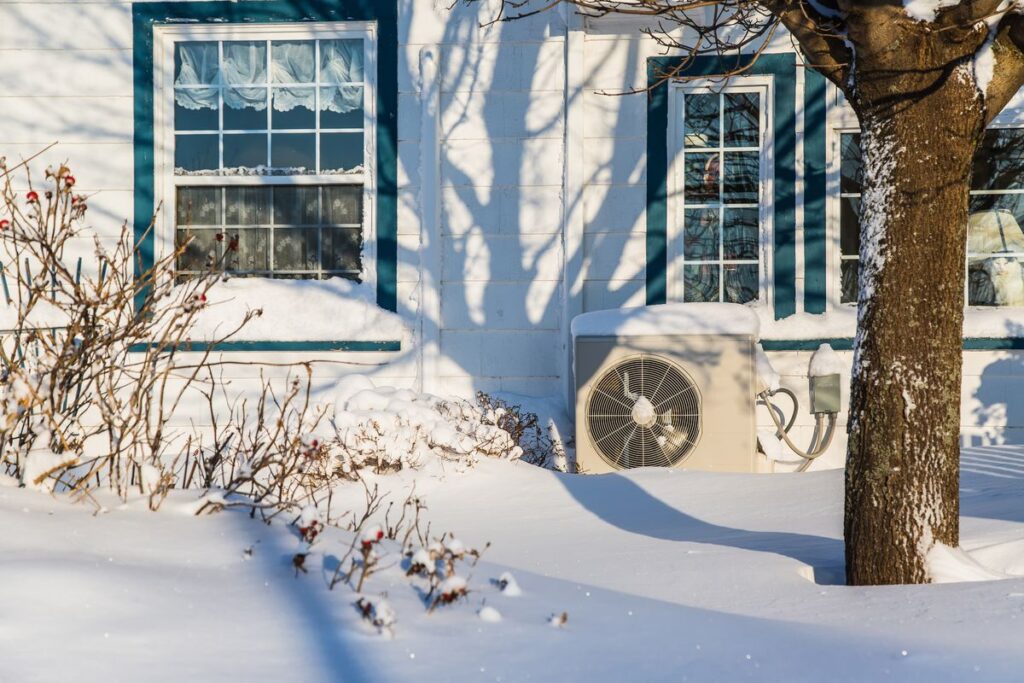Press inquiries
If you are a journalist and want to interview someone at Carbon Switch about this report, please email michael@carbonswitch.co.
Introduction
House and Senate Democrats are currently working to pass two bills that represent one of the biggest climate policy opportunities in more than a decade. Amidst the debate over what should and shouldn’t make it into these bills, there’s been much discussion about solar, wind and electric vehicles. And for good reason: to prevent catastrophic climate change, we need to deploy these technologies at unprecedented speed. But very little attention has been paid to another essential climate solution that can deliver similar emissions reductions: heat pumps.
Using data from the National Renewable Energy Laboratory (NREL) our team looked at what would happen if every home in America replaced their heating and cooling systems with heat pumps.
Highlights from this report
- Single-family home emissions would be reduced by 142 million metric tons per year. Given that homes currently emit about one billion metric tons per year and total energy related emissions in the United States is about 5 billion metric tons, this would lead to a 14% reduction in the sector and ~3% reduction in the country’s total emissions.
- The average homeowner would save $557 per year on their utility bill. In Senator Joe Manchin’s state of West Virginia, the average homeowner would save $887 per year.
- 6.6 million jobs would be created in counties all over the country. Once again if we turn our attention to West Virginia we see that 52,000 jobs would be created across the state (compared to the 33,000 jobs currently supported by the coal mining industry).
- Cold climates aren’t preventing heat pump adoption; the biggest barrier is cheap natural gas. In Maine, one of the coldest states, the average homeowner can save $718 per year. Yet in relatively moderate Colorado the average homeowner would only save $182. This data underscores the importance of eliminating fossil fuel subsidies and properly pricing carbon in order to drive heat pump adoption.
Single-family home emissions would be reduced by 142 million metric tons per year.
According to the Energy Information Agency (EIA), home energy is responsible for just under 1 billion metric tons of carbon pollution every year (20% of our country’s total energy-related emissions).
In single-family homes 54% of total energy goes towards heating and cooling (43% goes towards heating and 8% goes towards cooling). That’s why improving the way we heat and cool our homes represents such a large opportunity for carbon reductions.
Broadly speaking, the way to decarbonize the housing sector is to:
- Electrify all equipment and appliances…
- …with the most efficient technology available
- And transition to a 100% renewable grid
Today 65 million single-family homes (88%) use either fossil-fuel powered equipment or inefficient electric heating and cooling technology. Only 8.9 (12%) million use heat pumps. As we’ll cover below, one of the main reasons for this relatively small market share is that heat pumps cost more than inefficient systems.
Because heat pumps also act as air conditioners, it’s important to look at how Americans currently cool their homes. The table below shows the percentage of homes currently cooled with heat pumps (which includes mini-splits).
54.9 million (74%) homes use inefficient air conditioning systems, whereas 14.8 million (20%) homes use either a ducted heat pump or ductless mini-split.
Heating fuel market share
Heating equipment market share
Air conditioning equipment market share
Replacing all of those inefficient, fossil-fuel systems with heat pumps would result in a reduction of 141 million metric tons of emissions per year. To put that in context, that represents a 14% reduction in the housing sector and ~3% reduction in the country’s total emissions.
The two tables below break down that opportunity based on heating fuel and equipment type. (Note: All emissions figures represent metric tons of carbon dioxide equivalents per year).
Carbon reduction potential
By heating fuel
By heating equipment type
The average homeowner would save $557 per year on their utility bill
Heat pumps are the rare climate solution that doesn’t require personal sacrifice on behalf of consumers. Tens of millions of homeowners have the opportunity to save money and make their home more comfortable. In fact, the average homeowner in America can save $557 on their utility bill every year by switching to a heat pump.
But there is a large variance in savings depending on a home’s heating fuel, equipment, and location as the tables below demonstrate.
Two things are clear in looking at this data:
- Homeowners that use electricity, propane, and fuel oil can generally save about $1,000 per year. And with payback periods under 15 years it’s possible for many of these homeowners to install heat pumps with no money upfront and a low-interest loan. This represents one of the best opportunities for decarbonization in the housing sector.
- Homeowners that use natural gas to heat their homes on the other hand would only save $117 per year based on today’s natural gas prices. Therefore it will be very difficult to replace without substantial changes to the price of the fuel (i.e. a price on carbon) or large heat pump installation incentives.
Average savings, upfront cost, and payback period
By heating fuel
By equipment type
By state

6.6 million jobs would be created in counties all over the country
Replacing America’s inefficient heating and cooling equipment with heat pumps would also create enormous economic opportunities and jobs. And, importantly, those benefits could be reaped in every city, county, and state across the country.
In total, there’s an opportunity to create 6.6 million jobs. That includes direct (e.g. electricians), indirect (e.g. manufacturers) and induced jobs (e.g. local businesses that benefit from increased economic activity).
Below is a table that shows how many jobs can be created in each state. But we’d like to call attention to one state in particular: West Virginia, where Senator Joe Manchin will play a key role in shaping any bill passed this year.
In that state, 52,000 jobs would be created (compared to the 33,000 jobs currently supported by the coal mining industry).
Job creation potential
Replacing inefficient, fossil-fuel-powered HVAC equipment with heat pumps will be essential if America is to hit its climate goals. Yet compared to other climate solutions like solar, wind, and electric vehicles, heat pumps don’t enjoy mainstream popularity. That’s unfortunate given the important role they can play in decarbonizing the housing sector, which is responsible for nearly a billion metric tons of annual emissions (20% of our country’s total).
Conclusion
Compared to HVAC systems that run on natural gas, fuel oil, and propane, heat pumps enable zero-emissions heating and cooling (assuming we also decarbonize the power grid). Today, there are 65 million fossil-fuel heating systems in use in America. If those systems aren’t replaced with heat pumps, it will be impossible to decarbonize the housing sector.
Replacing the 8.9 million inefficient electric heating systems and 54.9 million inefficient air conditioning systems with heat pumps would also dramatically reduce the amount of renewable energy and transmission infrastructure our country would need to build. That’s because heat pumps use so much less energy per year than any other heating and cooling system.
As we’ve shown in this report, heat pumps are a rare climate solution: not only can they cut 142 million metric tons of carbon dioxide emissions and create 6.6 million jobs, but they can also save American homeowners an average of $557 on their utility bill.
Given all these benefits, we encourage policymakers to consider heat pumps as part of their larger decarbonization strategy.
Methodology
Most of our research work involves helping consumers understand how to dramatically reduce their personal carbon footprint. But as individuals our actions can only make so much impact. In order to prevent catastrophic climate change, we need policy change. That’s why we produce reports like this one and encourage our readers to get involved in political organizing and policy advocacy.
The initial idea for this analysis came whilst producing our series of guides on heat pumps (here, here and here). In doing our research we were frustrated by the lack of contextual data on carbon reduction and utility bill savings potential. We discovered that there was no comprehensive publicly available dataset that showed how much a homeowner could save based on where they lived and their current heating and cooling system.
We did, however, find a group of researchers at the National Renewable Energy Laboratory (NREL) studying energy efficiency in single-family homes. We emailed those researchers and received access to a treasure trove of the country’s most comprehensive energy efficiency data.
That NREL data came from a project called ResStock, a first-of-its-kind simulation engine that produced “unprecedented granularity and most importantly—accuracy—in modeling the diversity of the single-family housing stock.” Using that data we were able to accurately estimate carbon reductions, utility bill savings, upfront costs and payback periods based on heating fuel, equipment and location.
Without the ResStock model and the researchers’ generosity in sharing some of the data used to produce it, this analysis wouldn’t have been possible.
(Disclaimer: NREL wasn’t involved in our analysis in any way and the report doesn’t represent any of their views or recommendations as a government agency).
In order to estimate how many jobs could be created we used a model developed by Marilyn A. Brown, Anmol Soni, and Yufei Li at the Georgia Institute of Technology for their paper titled Estimating Employment From Energy-Efficiency Investments. In that paper they found that for every $1 million of spending on residential energy efficiency, 12.55 jobs were created. Our model combined the total cost data from NREL and the jobs per million metric presented in that paper.
